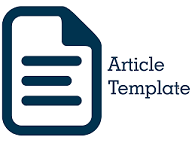Genre-Based Approach in Teaching BIPA
Abstract
Knowledge of various teaching strategies is one of the important things that teachers need to have. In this case, every teacher must equip themselves with a variety of teaching strategies to achieve success in teaching BIPA. The text-based approach is one of the approaches that teachers can apply in teaching BIPA. There have been many studies that prove the success of this approach. However, the use of text-based approaches to teaching BIPA is still rare. Therefore, this article aims to provide a brief overview of the use of a text-based approach in teaching BIPA. This paper will present an understanding of a text-based approach in general, the advantages of using a text-based approach in teaching BIPA, and examples of using a text-based approach in teaching BIPA.
Full Text:
PDFReferences
Ali, S., Idrees, M., & Iftikhar, A. (2009). Effectiveness of Layered Instructional Strategy for teaching English at Secondary Level. i-Manager's Journal of Educational Technology, 6(1), 82-87.
American Council on the Teaching of Foreign Languages. (2012). ACTFL Pedoman Kemahiran 2012. Alexandria, VA.
Artayasa, I. M., Sutama, I. M., & Utama, I. D. G. B.(2017). Pelaksanaan pembelajaran dengan menggunakan metode praktik langsung untuk siswa BIPA beginner class di Yayasan Cinta Bahasa Indonesian language school. Jurnal Pendidikan Bahasa dan Sastra Indonesia Undiksha, 7(2).
Azaz, M. (2016). Integrating the Genre-Based Approach into teaching writing in Arabic as a foreign language. Journal of the National Council of Less Common Taught Languages 19, 31-60.
Azizah, R. F., Hs, W., & Lestari, I. (2012). Pembelajaran Bahasa Indonesia bagi Penutur Asing (BIPA) Program CLS (Critical Language Scholarship) di Fakultas Sastra Universitas Negeri Malang Tahun 2012. Skripsi. Malang: Fakultas Sastra Universitas Negeri Malang.
Badger, R., & White, G. (2000). A process genre approach to teaching writing. ELT Journal, 54(2), 153-160.
Dickinson, P. (2013). A Genre-based Approach to preparing for IELTS and TOEFL essay writing tasks. Niigata University of International and Information Studies, 16, 1-9.
Dirgeyasa, I. W. (2016). Genre-Based Approach: what and how to teach and to learn writing. English Language Teaching, 9(9), 45.
Farrell, T. (2002). Lesson planning. In Richards, J. C., & Renandya, W. A. (Eds.). Methodology in language teaching: An anthology of current practice (pp. 30-39). Cambridge university press.
Hyon, S. (1996). Genre in three traditions: Implications for ESL. TESOL Quarterly, 30(4), 693-722.
Inderasari, E., & Agustina, T. (2017). Pembelajaran Bahasa Indonesia pada mahasiswa asing dalam program BIPA IAIN Surakarta. Jurnal Pendidikan Bahasa dan Sastra Indonesia, 6(2), 6-15.
Jazeri, M. (2016). Model perangkat pembelajaran keterampilan berbicara dengan pendekatan komunikatif kontekstual bagi mahasiswa asing. LITERA, 15(2), 217-226.
Kim, M. (2006). Genre-based approach to teaching writing. TESOL Working Paper Series, 4(2). 33-39.
Kusmiatun, A., & Pratiwi, N. (2019) Reaktualisasi pelatihan ke-BIPA-an menuju penyelenggaraan kelas bipa yang berkualitas. Makalah pada Konferensi Internasional Pengajaran Bahasa Indonesia bagi Penutur Asing (KIPBIPA) XI.
Lunenburg, F. C., & Irby, B. J. (2011). Instructional strategies to facilitate learning. International Journal of Educational Leadership Preparation, 6(4), 1-12.
Maharany, E.R. (2020). Pengembangan silabus pengajaran BIPA berbasis teks. Jurnal Pendidikan Bahasa dan Sastra, 10(1), 80-87.
Mayer, R. E. (2002). Rote versus meaningful learning. Theory into practice, 41(4), 226-232.
Nation, I. P., & Macalister, J. (2010). Language curriculum design. New York, NY: Routledge.
NSW Department of School Education. (1989). The discussion genre. Erskineville, NSW: DSP Printery. https://educationalsemiotics.files.wordpress.com/2012/11/tfw_discussion_language_social_power.pdf
Nugroho, T. & Hafrizon. (2009). Introduction to Genre Based Approach. https://mmursyidpw.files.wordpress.com/2009/05/introductiontogenrebasedapproach.pdf
Reppen, R. (1994). A genre-based approach to content writing instruction. TESOL Journal, 4(2), 32-35.
Richards, J. (2001). Curriculum development in language teaching. New York, NY: Cambridge University Press
Rosita, F. Y. (2019). Pengembangan teknik interactive-communicative games untuk keterampilan berbicara bipa kelas pemula. Jurnal Pendidikan Bahasa dan Sastra, 19(1), 51-60.
Sangoleye, S. A. (2016). A critique of selected instructional strategies in higher institutions in Nigeria. Journal of Education and Practice, 7(7), 78-84.
Sari, N. P. A. W., Sutama, I. M., & Utama, I. D. G. B. (2016). Pembelajaran Bahasa Indonesia bagi penutur asing (BIPA) di Sekolah Cinta Bahasa, Ubud, Bali. Jurnal Pendidikan Bahasa dan Sastra Indonesia Undiksha, 5(3).
Sulistyarini, I. (2016). Implementasi pembelajaran keterampilan berbicara pada program bahasa Indonesia bagi penutur asing di unit pelayanan dan pengembangan bahasa universitas sebelas maret surakarta. Thesis. Surakarta: Universitas Sebelas Maret.
Tiawati, R., & Lina, R. (2018). Perencanaan pembelajaran bahasa indonesia bagi penutur asing (BIPA) untuk tingkat pemula. Jurnal Gramatikal, 4, 393-402.
Turner, C. (2016). What matters most: Using high-traction instructional strategies to increase student success. NADE Digest, 9(1), 44-48.
Varuzza, M., Sinatra, R., Eschenauer, R., & Blake, B. E. (2014). The relationship between english language arts teachers' use of instructional strategies and young adolescents' reading motivation, engagement, and preference. Journal of Education and Learning, 3(2), 108-119.
Yang, Y. (2016). Teaching Chinese college ESL writing: A Genre-based Approach. English Language Teaching, 9(9), 36-44.
DOI: https://doi.org/10.24036/kolokium-pls.v9i2.481
Refbacks
- There are currently no refbacks.

This work is licensed under a Creative Commons Attribution 4.0 International License.

